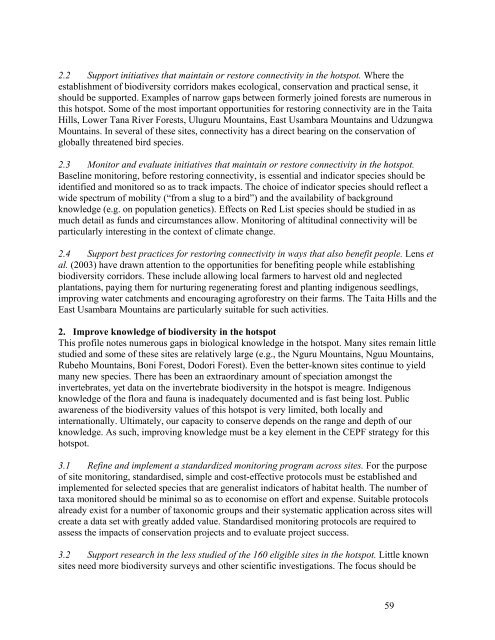Eastern Arc Mountains and Coastal Forests of Tanzania and Kenya ...
Eastern Arc Mountains and Coastal Forests of Tanzania and Kenya ...
Eastern Arc Mountains and Coastal Forests of Tanzania and Kenya ...
You also want an ePaper? Increase the reach of your titles
YUMPU automatically turns print PDFs into web optimized ePapers that Google loves.
2.2 Support initiatives that maintain or restore connectivity in the hotspot. Where theestablishment <strong>of</strong> biodiversity corridors makes ecological, conservation <strong>and</strong> practical sense, itshould be supported. Examples <strong>of</strong> narrow gaps between formerly joined forests are numerous inthis hotspot. Some <strong>of</strong> the most important opportunities for restoring connectivity are in the TaitaHills, Lower Tana River <strong>Forests</strong>, Uluguru <strong>Mountains</strong>, East Usambara <strong>Mountains</strong> <strong>and</strong> Udzungwa<strong>Mountains</strong>. In several <strong>of</strong> these sites, connectivity has a direct bearing on the conservation <strong>of</strong>globally threatened bird species.2.3 Monitor <strong>and</strong> evaluate initiatives that maintain or restore connectivity in the hotspot.Baseline monitoring, before restoring connectivity, is essential <strong>and</strong> indicator species should beidentified <strong>and</strong> monitored so as to track impacts. The choice <strong>of</strong> indicator species should reflect awide spectrum <strong>of</strong> mobility (“from a slug to a bird”) <strong>and</strong> the availability <strong>of</strong> backgroundknowledge (e.g. on population genetics). Effects on Red List species should be studied in asmuch detail as funds <strong>and</strong> circumstances allow. Monitoring <strong>of</strong> altitudinal connectivity will beparticularly interesting in the context <strong>of</strong> climate change.2.4 Support best practices for restoring connectivity in ways that also benefit people. Lens etal. (2003) have drawn attention to the opportunities for benefiting people while establishingbiodiversity corridors. These include allowing local farmers to harvest old <strong>and</strong> neglectedplantations, paying them for nurturing regenerating forest <strong>and</strong> planting indigenous seedlings,improving water catchments <strong>and</strong> encouraging agr<strong>of</strong>orestry on their farms. The Taita Hills <strong>and</strong> theEast Usambara <strong>Mountains</strong> are particularly suitable for such activities.2. Improve knowledge <strong>of</strong> biodiversity in the hotspotThis pr<strong>of</strong>ile notes numerous gaps in biological knowledge in the hotspot. Many sites remain littlestudied <strong>and</strong> some <strong>of</strong> these sites are relatively large (e.g., the Nguru <strong>Mountains</strong>, Nguu <strong>Mountains</strong>,Rubeho <strong>Mountains</strong>, Boni Forest, Dodori Forest). Even the better-known sites continue to yieldmany new species. There has been an extraordinary amount <strong>of</strong> speciation amongst theinvertebrates, yet data on the invertebrate biodiversity in the hotspot is meagre. Indigenousknowledge <strong>of</strong> the flora <strong>and</strong> fauna is inadequately documented <strong>and</strong> is fast being lost. Publicawareness <strong>of</strong> the biodiversity values <strong>of</strong> this hotspot is very limited, both locally <strong>and</strong>internationally. Ultimately, our capacity to conserve depends on the range <strong>and</strong> depth <strong>of</strong> ourknowledge. As such, improving knowledge must be a key element in the CEPF strategy for thishotspot.3.1 Refine <strong>and</strong> implement a st<strong>and</strong>ardized monitoring program across sites. For the purpose<strong>of</strong> site monitoring, st<strong>and</strong>ardised, simple <strong>and</strong> cost-effective protocols must be established <strong>and</strong>implemented for selected species that are generalist indicators <strong>of</strong> habitat health. The number <strong>of</strong>taxa monitored should be minimal so as to economise on effort <strong>and</strong> expense. Suitable protocolsalready exist for a number <strong>of</strong> taxonomic groups <strong>and</strong> their systematic application across sites willcreate a data set with greatly added value. St<strong>and</strong>ardised monitoring protocols are required toassess the impacts <strong>of</strong> conservation projects <strong>and</strong> to evaluate project success.3.2 Support research in the less studied <strong>of</strong> the 160 eligible sites in the hotspot. Little knownsites need more biodiversity surveys <strong>and</strong> other scientific investigations. The focus should be59
















